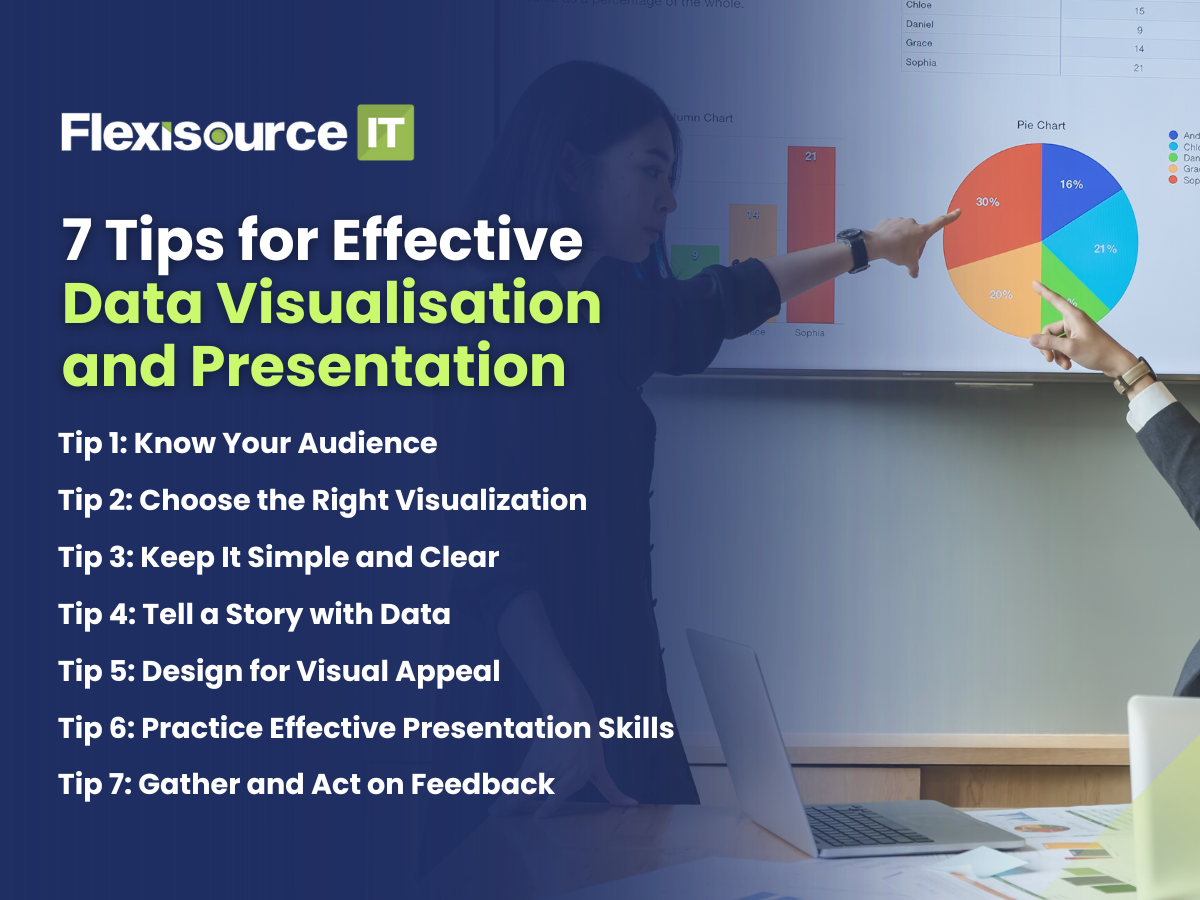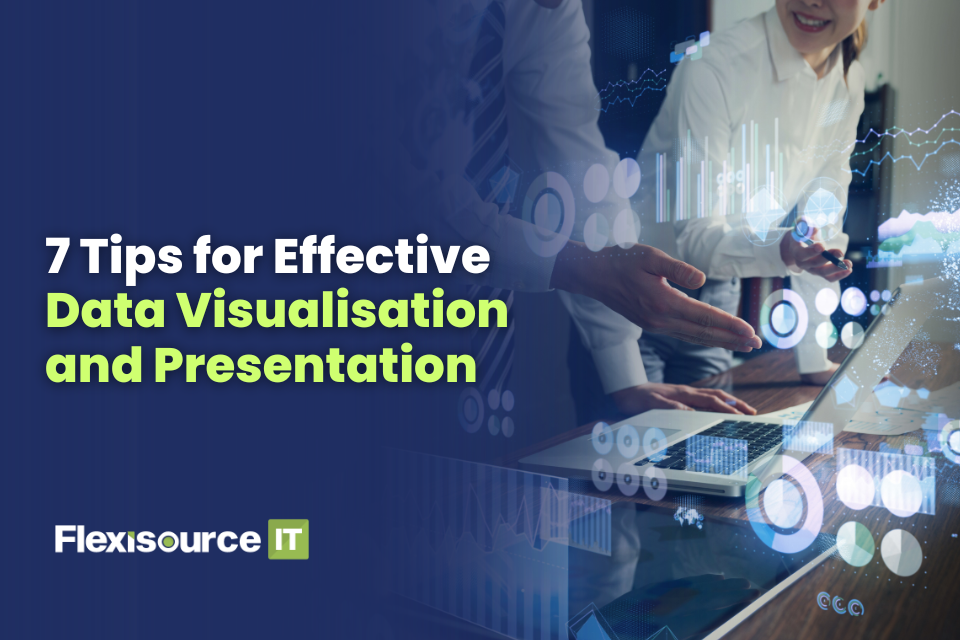Ever found yourself drowning in a sea of numbers, struggling to make your point heard? Well, you are not alone. Today, organisations have access to vast amounts of information. However, making sense of this data can be a challenging task.
This is where data visualisation and presentation come into play. Visualising data makes information easier to understand and analyse, enabling businesses to make informed decisions.
In this article, we’re diving into the art of data visualisation and presentation, uncovering seven invaluable tips to help you transform raw data into captivating stories. From choosing the right charts to mastering design principles, we’ve got you covered. So, grab your favourite data set, and let’s unleash the power of visual storytelling together!
What is data visualisation and presentation?
Data visualisation and presentation are two closely related concepts that involve the communication of data in a visual format to convey insights, trends, and patterns effectively.
Data visualisation is the process of representing data graphically to facilitate understanding and analytics. It involves converting raw data into tangible elements such as charts, graphs, maps, and diagrams. These visuals make it easier to identify trends, patterns, and relationships within the data that might not be apparent from looking at raw numbers or text.
On the other hand, Presentation refers to delivering information to an audience in a structured and engaging manner. While presentations can encompass a wide range of topics and formats, in the context of data, presentation involves sharing the insights gleaned from data visualisation with others.
What makes data visualisation effective?
To communicate insights clearly and compellingly, effective data visualisation has several key characteristics. These are some of the factors that make data visualisation effective:
- Effective visualisations are based on accurate and reliable data sources, and they accurately represent the underlying information without distortion or bias. The true nature of the data is reflected by the visualisation through careful attention to data integrity and validation.
- Accessibility ensures that data visualisations can be understood and interpreted by a wide range of audience members, including those with disabilities or limited technical expertise. Effective visualisations are designed with accessibility in mind, using clear labels, appropriate colour choices, and alternative formats as needed.
- Relevance. A good data visualisation focuses on the most important insights and trends relevant to the audience’s needs and interests. It highlights the key takeaways that drive understanding and decision-making and avoids overwhelming viewers with extraneous information.
- Clarity. Effective data visualisations are clear and easy to understand at a glance. They straightforwardly present information, avoiding unnecessary clutter and complexity. Clarity is achieved through concise labelling, appropriate scaling, and judicious use of visual elements.
- Context is essential for interpreting data correctly. This may include background information, relevant comparisons, and key trends or patterns explanations.
- Effective data visualisations are flexible and adaptable to different contexts and audiences. They can be easily customised or adjusted to accommodate varying levels of detail, other presentation formats, and changing analytical requirements.
- Finally, compelling data visualisations inspire action by presenting insights in a way that empowers viewers to make informed decisions or take meaningful next steps.
7 Tips for Effective Data Visualisation and Presentation

Tip 1: Know Your Audience
The first step in creating compelling data visualisations is to understand your audience. Answer these questions: Who are they? What do they care about? Understanding your audience is critical to crafting visualisations that resonate with them.
Thus, consider who will be viewing your presentation and what their needs, preferences, and level of expertise are. Tailoring your visualisations to your audience ensures that your message resonates with them, and they can quickly grasp your insights.
For example, suppose you’re presenting to a non-technical audience. In that case, you may need to avoid jargon and complex visualisations, opting for more straightforward charts and graphs that convey your key points.
On the other hand, if you’re presenting to fellow data nerds, feel free to dive into the nitty-gritty details. Tailor your visuals to your audience’s needs and watch their eyes light up with understanding.
Tip 2: Choose the Right Visualisation
When choosing the correct visualisation, ask yourself: bar chart or line graph? A pie chart or scatter plot?
Choosing the proper visualisation can make all the difference in how your data is perceived. Different types of data lend themselves to different types of visualisations, so selecting the one that best highlights your data’s patterns, trends, and relationships is essential.
Thus, always think about the story you want to tell and pick the visualisation that best brings that story to life. Need to show a trend over time? Reach for the trusty line graph. Want to compare different categories? A bar chart might be your best bet.
Experiment with different types of visualisations until you find the perfect fit for your data.
Tip 3: Keep It Simple and Clear
Here’s a secret: less is often more.
Avoid cluttering your visualisations with unnecessary elements or overwhelming your audience with too much information.
Likewise, use clean design principles, such as ample white space, consistent formatting, and easy-to-read fonts, to enhance readability and comprehension. Remember, the goal is not to impress with complexity but to communicate effectively.
Tip 4: Tell a Story with Data
Data might seem dry and dull, but the magic happens when you weave it into a compelling narrative. Great data visualisations do more than just present numbers—they tell a story. With that said, use your visualisations to guide your audience through a narrative, highlighting key points, identifying trends, and drawing conclusions.
Start by framing the context of your data and outlining the questions you aim to answer. Then, use your visualisations to illustrate how the data supports your narrative, emphasising the most compelling insights along the way. By crafting a coherent story, you can engage your audience and make your data more memorable and impactful.
Tip 5: Design for Visual Appeal
Visual appeal plays a significant role in the effectiveness of your data presentations. Well-designed visualisations not only capture attention but also enhance comprehension and retention of information.
Likewise, pay attention to colour choices, using them strategically to differentiate categories or highlight key data points. Incorporate visual elements like icons, labels, and annotations to provide context and aid interpretation. And don’t forget about accessibility—ensure that your visualisations are easy to understand for all members of your audience, including those with colour blindness or other visual impairments.
Tip 6: Practice Effective Presentation Skills
Even the most compelling data visualisations can fall flat without practical presentation skills. As such, practice delivering your presentation with confidence, clarity, and enthusiasm. Speak clearly and concisely, using simple language to explain complex concepts. Maintain eye contact with your audience and be prepared to answer questions.
In addition, use data storytelling techniques to captivate your audience’s attention and keep them engaged throughout your presentation. And don’t forget to practice timing—make sure your presentation flows smoothly and stays within the allotted time frame.
Tip 7: Gather and Act on Feedback
Finally, don’t underestimate the value of feedback in improving your data visualisations and presentations. Encourage your audience to provide input and insights, whether through formal surveys, informal discussions, or direct feedback channels. Pay attention to their reactions, questions, and suggestions, and use this information to refine and enhance your future presentations.
Conclusion
So, there you have it – seven tips for creating killer data visualisations and presentations. Whether presenting to a roomful of executives or just sharing insights with your team, these tips will help you communicate your message effectively and leave a lasting impression. So go forth, data warriors, and rock those presentations like a boss!
Ready to take your data presentation skills to the next level? Contact us to learn how our data visualisation experts can assist you in achieving your data communication goals.









